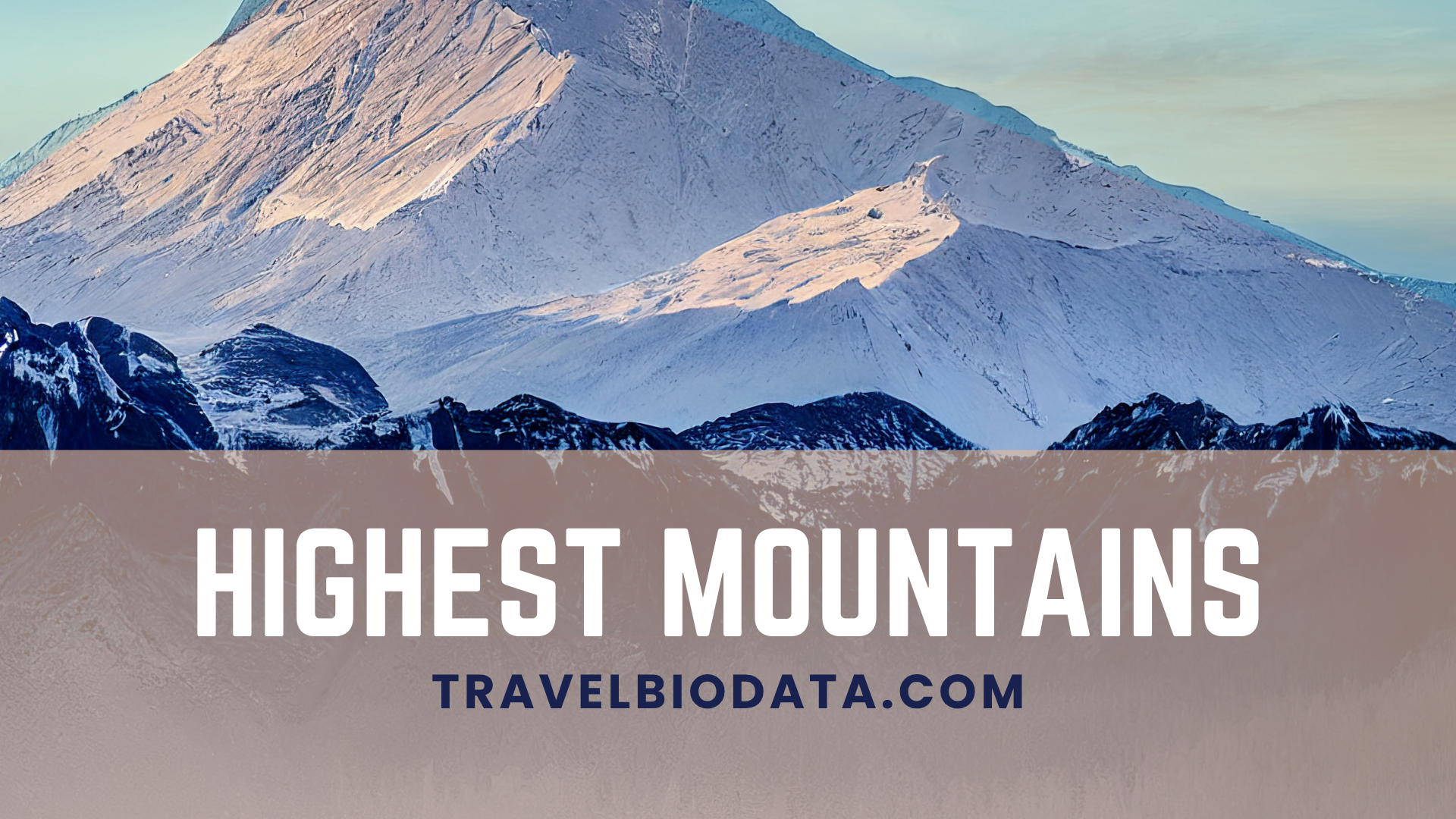
The World’s Highest Mountains
The world’s highest mountains are primarily located in Asia, particularly in the Himalayan and Karakoram ranges. Below is a table of the top 10 highest mountains globally, based on elevation above sea level:
| Mountain | Location | Elevation (meters) | Notes |
|---|---|---|---|
| Mount Everest | Nepal/China | 8,848 | Highest peak globally, first summited in 1953 by Hillary and Norgay. |
| K2 | Pakistan/China | 8,611 | Second-highest, known for dangerous weather. |
| Kangchenjunga | Nepal/India | 8,586 | Third-highest, sacred to locals. |
| Lhotse | Nepal | 8,516 | Connected to Everest via South Col. |
| Makalu | Nepal | 8,485 | Known for its pyramid shape. |
| Cho Oyu | Nepal/China | 8,201 | Considered an easier 8,000-meter peak. |
| Dhaulagiri | Nepal | 8,167 | Remote with challenging routes. |
| Manaslu | Nepal | 8,163 | Popular for technical climbing. |
| Nanga Parbat | Pakistan | 8,126 | Known for steep slopes and avalanche risk. |
| Annapurna I | Nepal | 8,091 | High fatality rate among climbers. |
These peaks, all in Asia, represent the pinnacle of mountaineering challenges and attract adventurers worldwide (Much Better Adventures).
Highest Mountains in Specific Regions
Below, we explore the highest mountains in England, Wales, Scotland, America (United States), the Lake District, the Alps, and Africa, providing key details and climbing insights.
Highest Mountains in England
England’s highest mountains are concentrated in the Lake District, Cumbria. Here are the top five:
| Mountain | Location | Elevation (meters) | Notes |
|---|---|---|---|
| Scafell Pike | Lake District | 978 | England’s highest, part of Southern Fells (WorldAtlas). |
| Scafell | Lake District | 964 | Challenging routes, near Scafell Pike. |
| Helvellyn | Lake District | 950 | Famous for Striding Edge route. |
| Skiddaw | Lake District | 931 | Gentle slopes, panoramic views. |
| Great Gable | Lake District | 899 | Popular for varied climbing routes. |
These peaks, part of the “Wainwrights” list, are ideal for hikers seeking scenic adventures (Live for the Outdoors).
Highest Mountains in Wales
Wales’ rugged terrain, especially in Snowdonia, hosts its tallest peaks. Here are the top five:
| Mountain | Location | Elevation (meters) | Notes |
|---|---|---|---|
| Snowdon (Yr Wyddfa) | Snowdonia | 1,085 | Wales’ highest, six main routes (Visit Wales). |
| Carnedd Llewelyn | Snowdonia | 1,064 | Stunning views in Carneddau range. |
| Glyder Fawr | Snowdonia | 999 | Varied routes in Glyderau range. |
| Crib Goch | Snowdonia | 923 | Challenging ridge walk. |
| Pen y Fan | Brecon Beacons | 886 | South Wales’ highest peak. |
Snowdon is a must-visit for its accessibility and views, while Pen y Fan offers a gentler hike (Countryfile).
Highest Mountains in Scotland
Scotland’s Highlands and Cairngorms host the UK’s tallest peaks, known as Munros. Here are the top five:
| Mountain | Location | Elevation (meters) | Notes |
|---|---|---|---|
| Ben Nevis | Highlands | 1,345 | UK’s highest, popular Mountain Track (VisitScotland). |
| Ben Macdui | Cairngorms | 1,309 | Plateau summit, second-highest. |
| Braeriach | Cairngorms | 1,299 | Remote, wild climbing experience. |
| Cairn Toul | Cairngorms | 1,291 | Stunning Cairngorms views. |
| Aonach Beag | Highlands | 1,234 | Challenging Nevis range climb. |
Ben Nevis attracts thousands annually, while Cairngorms peaks offer solitude.
Highest Mountains in America (United States)
The U.S., particularly Alaska, hosts North America’s tallest peaks. Here are the top five:
| Mountain | Location | Elevation (meters) | Notes |
|---|---|---|---|
| Denali | Alaska | 6,190 | North America’s highest, in Alaska Range. |
| Mount Saint Elias | Alaska/Canada | 5,489 | Remote, in Saint Elias Mountains. |
| Mount Foraker | Alaska | 5,304 | Impressive north face in Alaska Range. |
| Mount Bona | Alaska | 5,005 | Remote Saint Elias peak. |
| Mount Blackburn | Alaska | 4,996 | Challenging Wrangell Mountains climb. |
Denali is a bucket-list climb, while others are more remote.
Highest Mountains in the Lake District
The Lake District, in England’s Cumbria, hosts the country’s tallest peaks. Here are the top five:
| Mountain | Location | Elevation (meters) | Notes |
|---|---|---|---|
| Scafell Pike | Cumbria | 978 | England’s highest, Southern Fells. |
| Scafell | Cumbria | 964 | Challenging routes near Scafell Pike. |
| Helvellyn | Cumbria | 950 | Striding Edge is a highlight. |
| Skiddaw | Cumbria | 931 | Gentle slopes, Northern Fells. |
| Great Gable | Cumbria | 899 | Popular Western Fells climb. |
These peaks are part of the Wainwrights, beloved by hikers.
Highest Mountains in the Alps
The Alps, spanning eight European countries, are home to Europe’s tallest peaks. Here are the top five:
| Mountain | Location | Elevation (meters) | Notes |
|---|---|---|---|
| Mont Blanc | France/Italy | 4,808 | Alps’ highest, popular climb. |
| Dufourspitze | Switzerland | 4,634 | Monte Rosa massif, challenging. |
| Dom | Switzerland | 4,545 | Pennine Alps, varied routes. |
| Weisshorn | Switzerland | 4,506 | Pyramidal shape, Pennine Alps. |
| Matterhorn | Switzerland/Italy | 4,478 | Iconic pyramid-shaped peak. |
Note: Some sources suggest Mount Elbrus (5,642 meters) in Russia’s Caucasus Mountains as Europe’s highest, but it’s debated whether the Caucasus is part of the Alps (Britannica).
Highest Mountains in Africa
Africa’s peaks, often volcanic, are stunning. Here are the top five:
| Mountain | Location | Elevation (meters) | Notes |
|---|---|---|---|
| Mount Kilimanjaro | Tanzania | 5,895 | Africa’s highest, freestanding volcano. |
| Mount Kenya | Kenya | 5,199 | Extinct volcano, UNESCO site. |
| Mount Stanley | Uganda/DRC | 5,109 | Rwenzori Mountains, glaciated. |
| Mount Speke | Uganda/DRC | 4,890 | Rwenzori, challenging climb. |
| Mount Baker | Uganda/DRC | 4,844 | Rwenzori, scenic glaciers. |
Kilimanjaro is a top trekking destination, while Rwenzori peaks are less explored
Benefits of Mountain Climbing
Mountain climbing offers numerous rewards beyond reaching the summit:
- Enhances Problem-Solving Skills
Mountain climbing often involves navigating challenging terrains, solving route problems, and making quick decisions in unpredictable conditions. This can sharpen your problem-solving abilities and improve your ability to think on your feet, as noted in the A World to Travel article. For instance, climbers must assess weather changes, plan safe paths, and adapt to sudden obstacles, all of which enhance cognitive flexibility and strategic thinking. This benefit is particularly valuable in everyday life, where quick decision-making under pressure is often required. - Increases Environmental Awareness
Spending time in the mountains allows climbers to witness firsthand the beauty and fragility of nature, fostering a deeper appreciation for the environment. This can inspire individuals to become more environmentally conscious, supporting conservation efforts, as highlighted in the same source. The immersive experience of being surrounded by pristine landscapes can lead to a stronger commitment to protecting these areas, aligning with broader ecological goals. This benefit extends beyond the climb, influencing lifestyle choices and advocacy. - Develops Technical Skills
Depending on the type of climbing, individuals may need to learn various technical skills, such as rope work, anchor building, and using climbing equipment. These skills, as detailed in the A World to Travel article, are not only crucial for safety but can also be valuable in other areas of life requiring precision and attention to detail. For example, understanding how to set up anchors can translate to skills in engineering or construction, making this a transferable benefit that enhances professional capabilities. - Improves Diet and Nutrition Awareness
The physical demands of climbing necessitate proper fueling, leading climbers to realize that unhealthy food does not provide the necessary energy, as noted in the THE ENVIRONMENTOR article. This awareness encourages better eating habits and nutritional choices, ensuring climbers maintain optimal performance. For instance, climbers often shift to diets rich in proteins and carbohydrates, understanding the importance of nutrition for endurance and recovery, which can lead to long-term health improvements.
Frequently Asked Questions (FAQs)
What is the easiest way to climb Mount Kilimanjaro?
The Marangu Route, known as the “Coca-Cola Route,” is the easiest due to its gradual ascent and amenities.
How long does it take to climb Ben Nevis?
It typically takes 4-6 hours to ascend and 2-3 hours to descend, depending on fitness and weather.
What is the best time to climb Mount Everest?
Spring (April-May) and autumn (September-October) offer stable weather for climbing.
Are there dangers in mountain climbing?
Yes, risks include altitude sickness, falls, avalanches, and hypothermia. Proper training and gear are crucial.
Can beginners climb mountains?
Beginners can start with easier peaks like Snowdon or Scafell Pike, ideally with guides or groups.
Conclusion
Mountains symbolize human aspiration and nature’s grandeur. From Mount Everest’s towering heights to Scafell Pike’s scenic trails, each peak offers unique challenges and rewards. Whether you’re planning a climb or admiring from afar, these highest mountains inspire awe. Grab your hiking boots and explore these majestic wonders!

